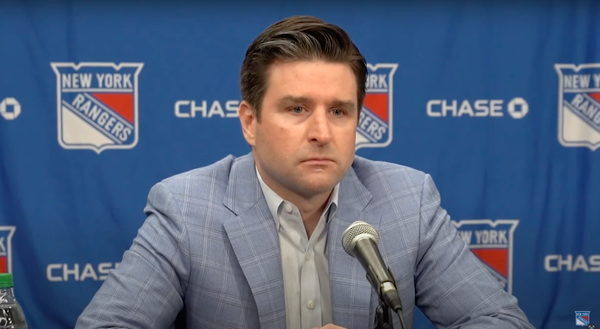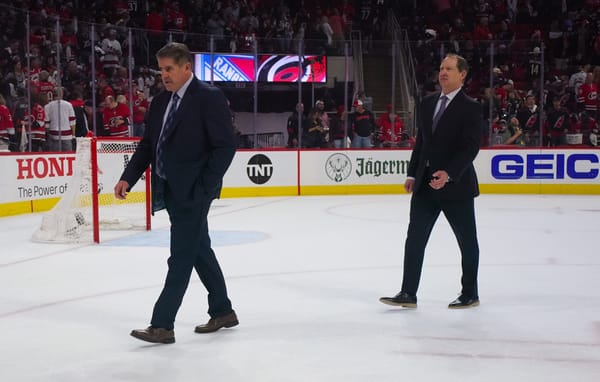New York Rangers analysis: Alain Vigneault made the Rangers a better possession team
With a new head coach, the Rangers are seeing more of the puck, which is a good thing.
Advanced statistics and how said numbers are interpreted are certainly up for debate when it comes to hockey these days. One thing that seems to be a consensus among most analysts and writers regardless of what camp they're in is that puck possession is good. Of every statistical measure that exists, 5v5 fen. close is the greatest predictor we have to predicting a team's future success.
The stats will also tell you the Rangers were better in holding onto the puck this year, which shouldn't be overlooked when trying to contextualize their success. Even when the Rangers weren't winning, it was a team with "good fancy stats" and didn't surprise some when they began to turn it around.
And make no mistake, the Rangers improved ability to hold onto the puck had a lot to do with Alain Vigneault.
What's important here is not comparing the Rangers numbers last year to the season prior, but to the 2011-12 campaign. The gap between the Rangers overall possession numbers between the last two years is marginal, but take that next season, and it's more significant. With a lockout shortened 2012-13 season, the smaller sample size provides less reliable data.
What exactly was involved in that change?
 More on puck possession
More on puck possession 
 More on puck possession
More on puck possession 
From that 48-game shortened season to the 82 games the Rangers played this past year, the team collectively jumped from 14th to sixth overall in the league in 5v5 fen. close. The team jumped nearly four percentage points up to 53.6, a very big step forward. The Rangers fen. close was actually higher during 2012-13—even if fractionally—and that should tell you those numbers are a bit unreliable.
What Vigneault did—along with install a different system that's geared toward holding onto the puck—is help change the personnel. If a system is predicated on one skill, it's obvious as an organization to go out and acquire players that can thrive in that system.
Under John Tortorella, the Rangers forechecked a good amount. That's an element of the game that only exists when a team does not have the puck. Forechecking isn't a useless skill, but to build a game plan around that, to be a "dump-and-chase" team is a poor strategy.
One of the bigger keys was ridding the roster of players incapable of driving possession. Some holdovers like Mats Zuccarello, Carl Hagelin, and Ryan McDonagh have all been strong in that area of the game for quite some time. Anton Stralman improved dramatically this season. Marc Staal (who was banged up that season) and Derek Stepan have also gotten markedly better. But reviewing that 2011-12 roster, and some of the names like Erik Christensen, Stu Bickel, Steve Eminger, Ruslan Fedotenko, and Mike Rupp are gone.
Getting rid of that dead weight was only half the solution. Many could have easily predicted getting rid of some of those aforementioned players would have yielded positive results. Finding diamonds in the rough like Benoit Pouliot, or a depth defenseman in Raphael Diaz speak more to Vigneault's ability to identify players who can thrive in his system. With the style he was implementing, Chris Kreider thrived (and also, Vigneault actually decided to play Kreider, unlike Tortorella).
This isn't to say all the personnel decisions fall on Vigneault. Rick Nash and Derrick Brassard were acquired the year before Vigneault arrived, but were good fits. With some of the pieces in place, and some picked by the new bench boss, it all came together under his system. The Rangers stopped dumping the puck in once they hit the red line, and instead, became a fluid passing team through the neutral zone, upping the temp, and keeping the puck off the other team's sticks.
Seeing guys like McDonagh and Staal excel was no surprise, as Vigneault encouraged defensemen to rush into the play, and get involved offensively. Under Tortorella, it was a more stay-at-home approach, and one that didn't showcase some of his blue liners skills, especially McDonagh.
This shouldn't have all come as a surprise. In Vigneault's two final full seasons in Vancouver, the Canucks finished fourth and eighth in 5v5 fen. close respectively.
All of this could pave the way for Jesper Fast, who has been a strong possession player in short NHL spans. (J.T. Miller, not so much. Tanner Glass ... well it's not even worth mentioning.)
The numbers could even get better. With key players in-and-out of the lineup because of injuries, and Vigneault getting the benefit of a full year with the bulk of the players (and another training camp) familiarity should no longer be an issue. Extrapolate the Rangers horrid start out of last year's larger scheme, and the results are glowing.
All stats via ExtraSkater.com




